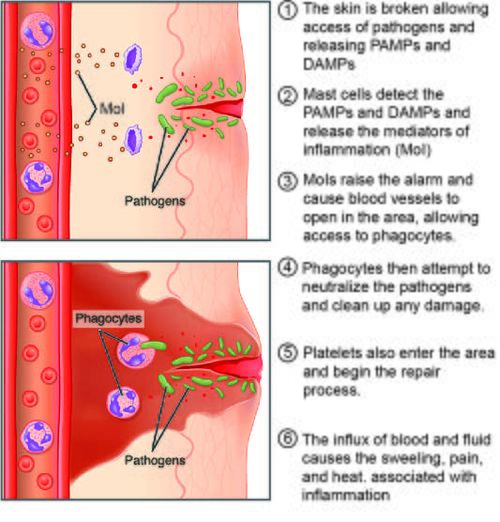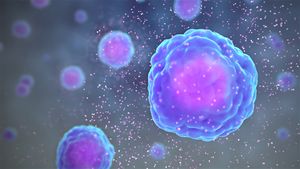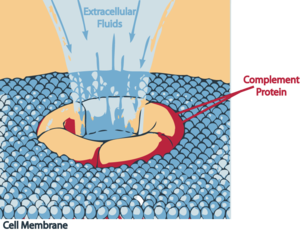Inflammation Acute and Chronic
Original Editor - Lucinda hampton
Top Contributors - Lucinda hampton, Bruno Serra, Rishika Babburu, Temitope Olowoyeye, Kim Jackson, Vidya Acharya and Sehriban Ozmen
Introduction[edit | edit source]
Inflammation has a major impact on our health and quality of life. It’s the trigger behind many chronic diseases and a growing burden affecting health care across the globe. What do we know about it?
Inflammation is the immune system's response to harmful stimuli eg. pathogens, damaged cells, toxic compounds, or irradiation, and acts by removing injurious stimuli and initiating the healing process.
- Inflammation is a defense mechanism that is vital to health. During acute inflammatory responses, cellular and molecular events and interactions efficiently minimize impending injury or infection. This process contributes to restoration of tissue homeostasis and resolution of the acute inflammation.
- Uncontrolled acute inflammation may become chronic, contributing to a variety of chronic inflammatory diseases[1]. Inflammation can be hence be either acute or chronic.
- Acute Inflammation - Tissue damage due to trauma, microbial invasion, or noxious compounds can induce acute inflammation. It starts rapidly, becomes severe in a short time and symptoms may last for a few days eg. cellulitis; acute pneumonia. Subacute inflammation is the period between acute and chronic inflammation and may last 2 to 6 weeks.
- Chronic Inflammation - Chronic inflammation is also referred to as slow, long-term inflammation lasting for prolonged periods of several months to years. Generally, the extent and effects of chronic inflammation vary with the cause of the injury and the ability of the body to repair and overcome the damage[2].
Process and Resolution of Inflammation.[edit | edit source]
In chronic inflammation most of the features of acute inflammation continue eg. the expansion of blood vessels (vasodilation), increase in blood flow, capillary permeability and migration of neutrophils into the infected tissue through the capillary wall (diapedesis). However, the composition of the white blood cells changes soon and the macrophages and lymphocytes begin to replace short-lived neutrophils. The hallmarks of chronic inflammation are the infiltration of the primary inflammatory cells such as macrophages, lymphocytes, and plasma cells in the tissue site, producing inflammatory cytokines, growth factor and enzymes. This all contributes to the progression of tissue damage and secondary repair including fibrosis and granuloma formation. [2]
- To prevent progression from acute inflammation to persistent chronic inflammation, the inflammatory response must be suppressed to prevent additional tissue damage. Inflammation resolution is a well-managed process involving the controlled production of mediators, during which chemokine gradients are diluted over time. Circulating white blood cells eventually no longer sense these gradients and are not recruited to sites of injury.
- Dysregulation of this process can lead to uncontrolled chronic inflammation. Inflammation resolution processes that rectify tissue homeostasis include reduction or cessation of tissue infiltration by neutrophils and apoptosis of spent neutrophils, counter-regulation of chemokines and cytokines, macrophage transformation from classically to alternatively activated cells, and initiation of healing.[1]
Causes[edit | edit source]
Chronic inflammation is not obvious and often insidious and often begins without an apparent cause. Our modern society is replete with inflammation triggers. These can be found in cigarette smoke; pollutants in our air, water or food; our gut microbiomes; and in mental cues, such as stress. As a result of our environment and lifestyles, we now live constantly with low levels of inflammatory signals “arming” our immune systems. This is a silent menace, not causing the usual overt signs of inflammation, but nevertheless complicating other disease processes that may be present[3]. Examples of when Chronic inflammation can develop below:
- Exposure: Sometimes, long-term, low-level exposure to an irritant, eg an industrial chemical, smoke, air pollution, causes chronic inflammation.
- Sensitivity: Inflammation happens when the body senses something that should not be there. Hypersensitivity to an external trigger can result in an allergy.
- Autoimmune disorders: The immune system mistakenly attacks normal healthy tissue, as in psoriasis.
- Autoinflammatory diseases: A genetic factor affects the way the immune system works, as in Behçet’s disease.
- Persistent acute inflammation: In some cases, a person may not fully recover from acute inflammation. Sometimes, this can lead to chronic inflammation.
Factors that may increase the risk of chronic inflammation include:
- older age
- obesity
- a diet that is rich in unhealthful fats and added sugar
- smoking
- low sex hormones
- stress
- sleep[2]
Damage[edit | edit source]
Scientists think chronic inflammation causes oxidative stress in the body, which is an imbalance between the production of dangerous free radicals, molecules that harm healthy tissue in the body, and antioxidants, substances that clean up waste products and neutralize them. This can damage DNA as well as proteins and fatty tissue, which in turn accelerates biological aging.
Chronic inflammation is involved in not just a few select disorders but a wide variety of very serious physical and mental health conditions. Indeed, chronic inflammatory diseases are the most significant cause of death in the world today, with more than 50 percent of all deaths being attributable to inflammation-related diseases.[4]
Chronic Inflammatory Complications[edit | edit source]
It is important to note that chronic inflammation is not a specific disease but a mechanistic process. Chronic inflammation progresses silently. It is the cause of most chronic diseases and presents a major threat to the health and longevity of individuals. The diseases associated with chronic inflammation are multiple.
- Cardiovascular diseases: Many clinical studies have shown strong and consistent relationships between markers of inflammation and cardiovascular disease. Atherosclerosis is a pro-inflammatory state with all the features of chronic low-grade inflammation and leads to increase cardiovascular events eg. myocardial infarction, stroke.
- Cancer: Chronic low-level inflammation also appears to participate in many types of cancer such as kidney, prostate, ovarian, hepatocellular, pancreatic, colorectal, lung, and mesothelioma.
- Diabetes: Immune cells like macrophages infiltrate pancreatic tissues releasing pro-inflammatory molecules in diabetic individuals. Both circulating and cellular biomarkers underscore that diabetes is a chronic inflammatory disease. Chronic complications linked to diabetes include both microvascular and macrovascular complications. Diabetes not only increases the risk of macrovascular complications like strokes and heart attacks but also microvascular complications like diabetic retinopathy, neuropathy, and nephropathy.
- Rheumatoid arthritis
- IBD: a group of chronic inflammatory disorders of the digestive tract. It can develop as ulcerative colitis causing long-lasting inflammation and ulcers in the lining of large intestine and rectum or Crohn's disease characterized by inflammation of the lining of digestive tract dispersing into affected tissues such as mouth, esophagus, stomach and the anus.
- Chronic kidney disease: Low-grade inflammation is a common feature of chronic kidney disease. It can lead to the retention of several pro-inflammatory molecules in the blood and contributes to the progression of CKD and mortality.
- Allergic asthma
- COPD
- Alzheimer’s: In older adults, chronic low-level inflammation is linked to cognitive decline and dementia.[2]
- Metabolic Syndrome
- Multiple Autoimmune Syndrome
Physiotherapy[edit | edit source]
A physical therapist can be an educator on the reduction of risk and lifestyle modifications. Emphasis is on diet and lifestyle modification eg weight loss, regular exercises, smoking cessation, healthy diet, and good sleep hygiene.
- Physical Exercise: In human clinical trials, it is shown that energy expenditure through exercise lowers multiple pro-inflammatory molecules and cytokines independently of weight loss.[2]
- Avoiding smoking and alcohol and reducing stress levels.
- A variety of foods have anti-inflammatory properties. These include foods that are high in antioxidants and polyphenols, such as: olive oil; leafy greens, such as kale and spinach; tomatoes; fatty fish, such as salmon, sardines, and mackerel; nuts; fruits, especially cherries, blueberries, and oranges
- Certain supplements may help to reduce inflammation. Fish oil, lipoic acid, and curcumin are all linked to decreases inflammation associated with diseases eg. cancer and heart disease. Several spices may also help with chronic inflammation and inflammatory disease, including ginger, garlic, and cayenne.
- The Mediterranean diet has been found in studies to lower markers of inflammation[5].
References[edit | edit source]
- ↑ 1.0 1.1 Chen L, Deng H, Cui H, et al. Inflammatory responses and inflammation-associated diseases in organs. Oncotarget. 2017;9(6):7204-7218. Published 2017 Dec 14. doi:10.18632/oncotarget.23208 Available from: https://www.ncbi.nlm.nih.gov/pmc/articles/PMC5805548/(accessed 22.1.2021)
- ↑ 2.0 2.1 2.2 2.3 2.4 Pahwa R, Jialal I. Chronic inflammation.2019 Available from:https://www.ncbi.nlm.nih.gov/books/NBK493173/ (accessed 21.1.2021)
- ↑ The Conversation Explainer: what is inflammation and how does it cause disease? Available from: https://theconversation.com/explainer-what-is-inflammation-and-how-does-it-cause-disease-84997(accessed 23.1.2021)
- ↑ The washington post Chronic Inflammation Available from: https://www.washingtonpost.com/health/chronic-inflammation-is-long-lasting-insidious-dangerous-and-you-may-not-even-know-you-have-it/2020/01/17/93ab0fa2-316f-11ea-9313-6cba89b1b9fb_story.html (accessed22.1.2021)
- ↑ Health line Understanding and Managing Chronic Inflammation Available from: https://www.healthline.com/health/chronic-inflammation(last accessed 23.1.2021)










